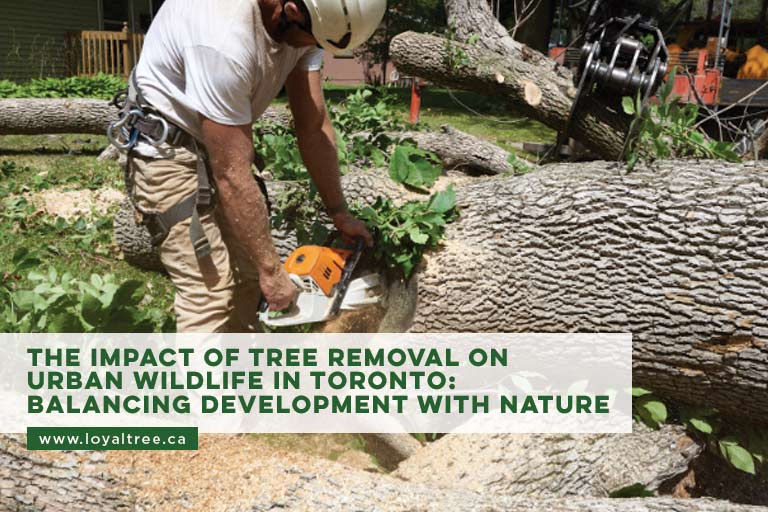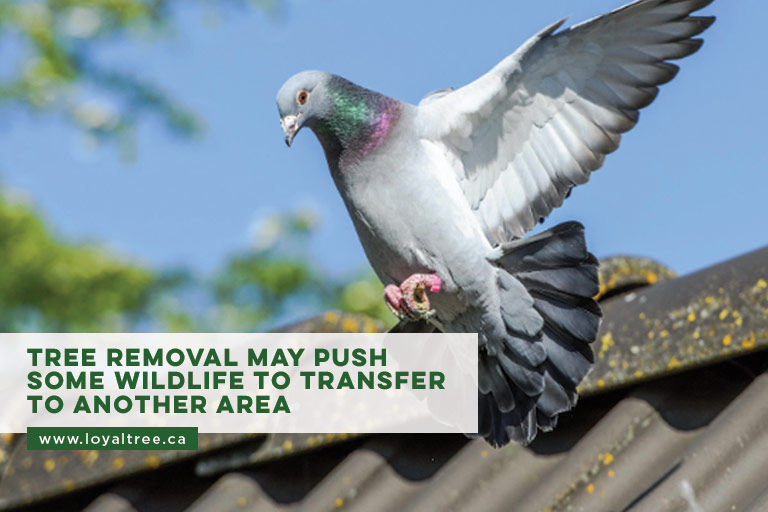
Urban development often necessitates tree removal, but this can have significant consequences for wildlife. In Toronto, where green spaces are crucial habitats, the balance between development and nature is delicate.
When trees are removed, local animals lose their homes and food sources, which can lead to a noticeable decline in urban wildlife. This highlights the importance of thoughtful city planning that respects and preserves natural habitats.
The Role of Trees in Urban Ecosystems
Trees play a vital role in urban ecosystems, contributing significantly to urban biodiversity. They provide essential habitats and food sources for various species, from birds and insects to small mammals. Trees create a layered environment where different animals can find shelter and sustenance. Birds nest in their branches, squirrels forage for nuts, and insects thrive on their leaves and bark.
A study published in the journal Urban Forestry & Urban Greening found that urban areas with higher tree density support greater bird diversity and abundance. This underscores the importance of trees in providing critical habitats within city environments.
Beyond their role as habitats, trees are crucial for maintaining air quality and regulating the urban climate. They absorb pollutants like carbon dioxide, sulphur dioxide, and nitrogen oxides, acting as natural air filters. Through the process of photosynthesis, trees release oxygen, which is essential for all living beings. Trees also help mitigate the urban heat island effect by providing shade and releasing moisture into the air, which cools the surrounding area.
Urban Wildlife in Toronto
Toronto is home to a rich diversity of urban wildlife, with species that have adapted remarkably well to city life. Common urban wildlife includes birds like the Northern Cardinal, American Robin, and Black-capped Chickadee. Small mammals such as squirrels, raccoons, and rabbits are also frequent inhabitants. Various insects, including bees and butterflies, also thrive in the city's green spaces.
Trees are crucial for these urban wildlife species. For birds, trees offer nesting sites, shelter from predators, and a rich supply of food such as insects and fruits. Small mammals use trees for nesting, foraging, and as escape routes from danger. Insects, particularly pollinators like bees and butterflies, rely on trees for nectar, pollen, and habitat.
Several species rely heavily on urban trees for survival. The Eastern Grey Squirrel, for example, nests in tree cavities and feeds on nuts and seeds found in tree canopies. The Downy Woodpecker excavates nesting sites in dead or dying trees and searches for insects beneath the bark. Monarch butterflies depend on specific tree species for shelter and food during their migration.
Causes and Consequences of Tree Removal
Tree removal in Toronto is driven by several factors, including urban development projects that require clearing land for construction, concerns over diseased or hazardous trees, and safety considerations such as potential falling branches. While these actions may be necessary for human safety and urban growth, they have significant consequences for urban wildlife populations.
Factors Driving Tree Removal
Urban development projects often lead to large-scale tree removals as green spaces are transformed into residential or commercial areas. Diseased trees, especially those affected by pests or fungal infections, are removed to prevent the spread of disease to nearby trees. Safety concerns arise from trees that are damaged or weakened, posing risks to people and property during storms or high winds.
Impacts on Urban Wildlife

The removal of trees can have both short-term and long-term impacts on urban wildlife. In the short term, animals lose their habitats and food sources, which can lead to displacement and increased competition for resources.
Some species may adapt by moving to other areas or adjusting their behaviours, while others may struggle to survive. Over the long term, reduced tree cover affects biodiversity, as certain species may decline or disappear from the area altogether.
Balancing Development with Wildlife Preservation
In Toronto, striking a balance between urban development and wildlife preservation is a critical challenge. Current policies and regulations aim to manage tree removal while considering the needs of both city growth and the preservation of urban habitats.
Policies and Regulations on Tree Removal
Toronto has various regulations in place to govern tree removal. The City's Urban Forest Management oversees permits for tree removal on private and public properties. These permits ensure that tree removal is conducted responsibly, taking into account factors such as the health of the tree, its impact on the environment, and replacement requirements. Specific guidelines will also address tree protection during development projects to minimize negative impacts on urban green spaces.
Initiatives and Programs for Wildlife Preservation
Several initiatives and programs in Toronto focus on preserving urban wildlife habitats amidst ongoing development. For instance, the Green Streets program promotes the planting of trees and shrubs along streetscapes to enhance biodiversity and provide wildlife corridors. The Toronto Wildlife Centre works to rehabilitate injured or orphaned wildlife and raises awareness about coexisting with urban wildlife.
Mitigation Strategies

Implementing effective mitigation strategies often involves consulting with an arborist in Toronto. Arborists play a crucial role in assessing tree health, recommending pruning techniques that maintain habitat structures, and ensuring responsible tree removal practices that minimize disturbance to urban wildlife.
Best Practices for Minimizing Impact
Several best practices can minimize the impact of tree removal on wildlife. These include conducting thorough ecological assessments before tree removal to identify sensitive habitats and species, implementing habitat restoration plans that include planting native vegetation and creating artificial habitats, and using tree pruning techniques that maintain habitat structures and minimize disturbance to wildlife.
Role of Urban Planning
Urban planning plays a vital role in creating wildlife-friendly cities by integrating green infrastructure and biodiversity considerations into city planning processes. This includes preserving existing green spaces, incorporating wildlife corridors and connectivity into urban designs, and promoting mixed land use that supports both human activities and wildlife habitats.
Community Involvement and Public Awareness
Engaging the community and raising public awareness is essential for successful wildlife preservation efforts. Community involvement can include participatory planning processes where residents contribute to decision-making on urban green spaces and wildlife habitats.
Public awareness campaigns can educate residents about the importance of urban wildlife, promote responsible pet ownership to reduce wildlife disturbance and encourage habitat conservation efforts in residential areas.
Reforestation and Habitat Restoration Efforts
Reforestation and habitat restoration efforts play a crucial role in enhancing urban biodiversity and supporting wildlife recovery in Toronto. These initiatives aim to replenish tree cover, restore natural habitats, and create sustainable environments for urban wildlife.
Examples of Reforestation Projects
Toronto has implemented various reforestation projects to enhance urban green spaces and support wildlife habitats. The High Park Nature Centre engages in tree planting events and habitat restoration projects within High Park, a significant green space in the city.
Impact of Habitat Restoration on Urban Wildlife Recovery
Habitat restoration efforts have shown positive impacts on urban wildlife recovery in Toronto. By restoring native vegetation and creating habitat structures, these projects provide essential food sources, nesting sites, and corridors for wildlife species. They contribute to the resilience of urban ecosystems, supporting populations of birds, mammals, insects, and other wildlife that depend on healthy habitats to thrive.
How Residents Can Get Involved
Residents can actively participate in local reforestation efforts by volunteering for tree-planting events organized by community groups, conservation organizations, and the City of Toronto.
These events provide opportunities for hands-on involvement in restoring urban green spaces and creating wildlife-friendly habitats. Residents can also support habitat restoration through initiatives such as lawn habitat creation, native plant gardening, and advocating for green infrastructure in their neighbourhoods.
Innovative Approaches to Urban Development
In the face of urbanization, innovative approaches to development that prioritize both nature and human needs are emerging worldwide. These approaches aim to integrate green spaces, biodiversity conservation, and sustainable practices into urban planning.
Examples of Innovative Urban Development Projects
Cities around the world have implemented pioneering projects that successfully balance nature and development. For instance, Singapore's "City in a Garden" initiative incorporates green roofs, vertical gardens, and extensive tree planting to enhance biodiversity and improve urban living conditions.
Potential Applications for Toronto
Toronto has the opportunity to adapt and implement similar innovative approaches to urban development. The city can explore the integration of green infrastructure such as green roofs, urban forests, and biodiversity corridors into its urban planning strategies.
Projects like the redevelopment of industrial sites into mixed-use green spaces and the enhancement of waterfront areas with natural habitats can enhance biodiversity and create enjoyable urban environments for residents.
Future Trends in Urban Planning and Wildlife Conservation
Future trends in urban planning are increasingly focusing on sustainability and wildlife conservation. Concepts like biophilic design, which integrates natural elements into urban environments to enhance human well-being, are gaining traction.
Cities are also adopting nature-based solutions to address climate change impacts, such as restoring wetlands and creating green infrastructure to manage stormwater.
Nurturing Toronto's Natural Harmony
As we reflect on the intricate relationship between urban growth and wildlife conservation in Toronto, it's evident that our actions today shape the future of our city's biodiversity. By advocating for green initiatives, participating in local reforestation projects, and embracing innovative urban planning, we can foster environments where wildlife flourishes alongside urban development.
Let's prioritize the preservation of our urban forests and promote responsible tree management practices. For guidance on tree removal in Toronto, reach out to Loyal Tree at (647) 283-8556 and join us in safeguarding Toronto's natural heritage for generations to come.
Comments